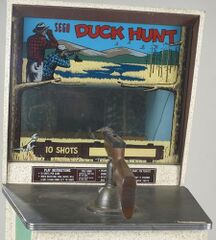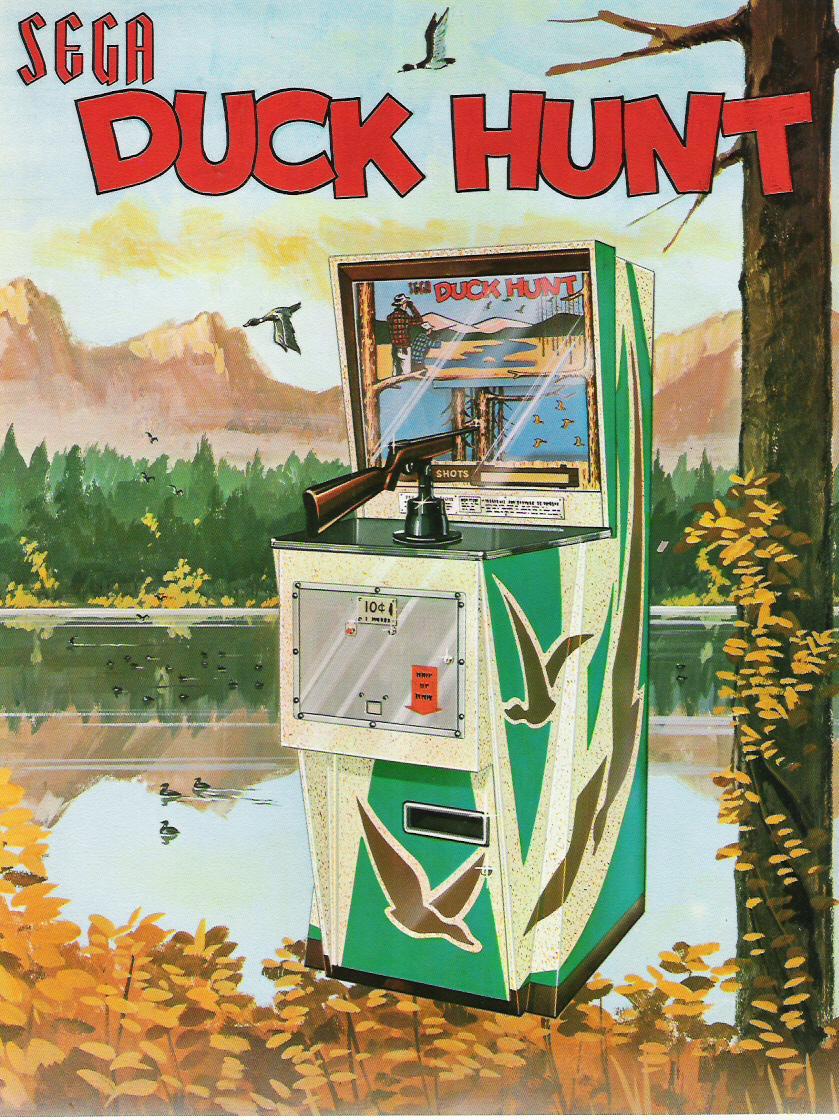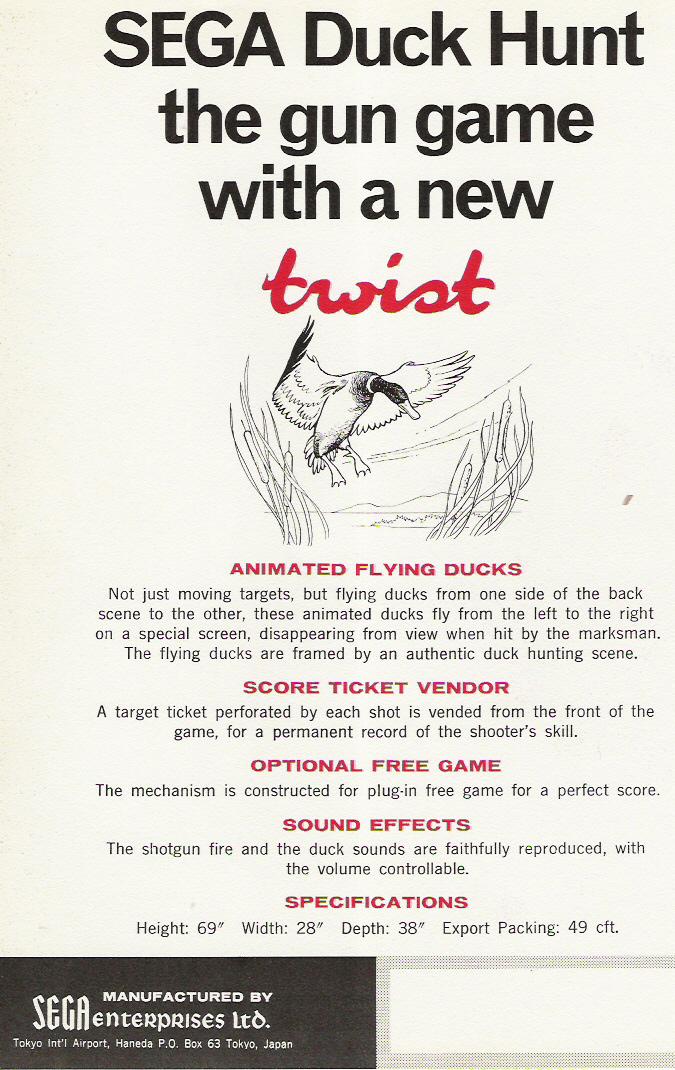Difference between revisions of "Duck Hunt"
From Sega Retro
m |
m (→Overview) |
||
| Line 19: | Line 19: | ||
This was the first electronic arcade game with animated targets displayed on a screen, in contrast to earlier EM arcade games that displayed actual physical static targets. This gave ''Duck Hunt'' the appearance of a video game, several years before the first true video games arrived in the arcades (''Computer Space'' and ''Pong''). ''Duck Hunt'' thus anticipated the kind of light-gun shooter video games that would later appear in the 1970s, and was the first electronic arcade game to display a first-person perspective on a screen. ''Duck Hunt'' was later updated by Midway and re-released in January 1973. | This was the first electronic arcade game with animated targets displayed on a screen, in contrast to earlier EM arcade games that displayed actual physical static targets. This gave ''Duck Hunt'' the appearance of a video game, several years before the first true video games arrived in the arcades (''Computer Space'' and ''Pong''). ''Duck Hunt'' thus anticipated the kind of light-gun shooter video games that would later appear in the 1970s, and was the first electronic arcade game to display a first-person perspective on a screen. ''Duck Hunt'' was later updated by Midway and re-released in January 1973. | ||
| + | |||
| + | Purchase of a ''{{PAGENAME}}'' machine comes with one roll of 3,000 paper cards. Replacement rolls could be acquired from [[Sega Enterprises]] for ¥3,000 each.{{fileref|1977SegaPriceList JP.pdf|page=6}} | ||
==Specifications== | ==Specifications== | ||
Revision as of 23:07, 25 August 2023

| |||||||||||||
| Duck Hunt | |||||||||||||
|---|---|---|---|---|---|---|---|---|---|---|---|---|---|
| System(s): Electro-mechanical arcade | |||||||||||||
| Publisher: Sega | |||||||||||||
| Developer: Sega | |||||||||||||
| Genre: Shoot-'em-Up | |||||||||||||
| Number of players: 1 | |||||||||||||
|
This short article is in need of work. You can help Sega Retro by adding to it.
Duck Hunt is a 1968 electro-mechanical arcade shooter game produced by Sega. A 25-cent video projection game, it features 10 animated ducks flying on a screen from left to right which disappear when shot with the attached shotgun controller.
The player receives ten shots, and the shot ducks are framed in a duck hunting score. Shooting the shot gun and hitting a duck produces a sound effect. The game dispenses a perforated computer card-style ticket showing shooting accuracy and score when game is finished which could be used for prizes or as a permanent record of the player's score. Additionally, the game could be set to give a free game for a perfect score.
Contents
Overview
It resembles a first-person light-gun shooter video game, but is in fact a video projection electro-mechanical (EM) game, using rear image projection in a manner similar to a zoetrope to produce moving animations on a screen.
This was the first electronic arcade game with animated targets displayed on a screen, in contrast to earlier EM arcade games that displayed actual physical static targets. This gave Duck Hunt the appearance of a video game, several years before the first true video games arrived in the arcades (Computer Space and Pong). Duck Hunt thus anticipated the kind of light-gun shooter video games that would later appear in the 1970s, and was the first electronic arcade game to display a first-person perspective on a screen. Duck Hunt was later updated by Midway and re-released in January 1973.
Purchase of a Duck Hunt machine comes with one roll of 3,000 paper cards. Replacement rolls could be acquired from Sega Enterprises for ¥3,000 each.[3]
Specifications
Dimensions
History
Background
In the late 1960s, Japanese companies Kasco (Kansei Seiki Seisakusho Co.) and Sega introduced a new type of electro-mechanical game, video projection games. They looked and played like later arcade video games, but relied on electro-mechanical components to produce sounds and images rather than a CRT display. They used rear video image projection to display moving animations on a video screen.[4][5][6] Video projection games became common in arcades of the 1970s. They combined electro-mechanical and video elements, laying the foundations for arcade video games, which adapted cabinet designs and gameplay mechanics from earlier video projection games.[6] They also ocassionally used solid-state electronics for sounds (like Grand Prix, Missile and Night Rider).
Legacy
After Duck Hunt, Sega produced several more electro-mechanical arcade games based on similar technology, using rear image projection to produce moving animations on a screen. In 1969, Sega released the EM games Grand Prix, a first-person driving/racing game like Kasco's Indy 500 that projects a forward-scrolling road on a screen, and Missile, a first-person vehicle combat simulation that had a moving film strip project targets on screen and a dual-control scheme where two directional buttons move the player tank and a two-way joystick with a fire button shoots and steers missiles onto oncoming planes, which explode when hit; in 1970, Missile was released in North America as S.A.M.I. Sega's Jet Rocket in 1970 was the earliest first-person shooter and combat flight simulator game, with cockpit controls that could move the player aircraft around a landscape displayed on screen and shoot missiles onto targets that explode when hit. In 1972, Sega released Killer Shark, a first-person light gun game known for appearing in the 1975 film Jaws.
The game also may have influenced Nintendo's light-gun shooters. In 1974, Nintendo's arcade light gun shooter Wild Gunman was a video projection EM game that used similar technology, but improved on it by using full-motion video projection to display live-action cowboy opponents on screen. In 1984, Nintendo released their own video game called Duck Hunt, which played similarly to Sega's 1969 electro-mechanical arcade game of the same name.
Duck Hunt may have also influenced Kasco's 1975 arcade game Gun Smoke, a light gun shooter that was the first holographic 3-D game. It was a hit in Japan, selling 6,000 cabinets there, but only 750 cabinets were sold in the US.[7] It was followed by two more holographic Kasco gun games, Samurai and Bank Robber, released between 1975 and 1977, as well as a 1976 Midway clone, Top Gun. The first holographic video games would later be Sega's Time Traveler (1991) and Holosseum (1992).[8]
Promotional material
Photo gallery
References
- ↑ http://thetastates.com/eremeka/1969prior.html (Wayback Machine: 2023-08-21 09:33)
- ↑ Billboard (December 28, 1968), page 33
- ↑ 1977 Sega Price List, page 6
- ↑ Killer Shark: The Undersea Horror Arcade Game from Jaws, D.S. Cohen, About.com
- ↑ Kasco and the Electro-Mechanical Golden Age (Interview), Classic Videogame Station ODYSSEY, 2001
- ↑ 6.0 6.1 Once Upon a Time on the Screen: Wild West in Computer and Video Games, Academia
- ↑ Gun Smoke
- ↑ Holograms: A Cultural History, page 179





